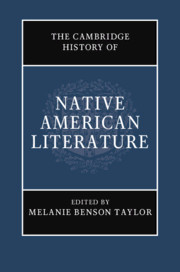Book contents
- The Cambridge History of Native American Literature
- The Cambridge History of Native American Literature
- Copyright page
- Contents
- Figures
- Contributors
- Introduction: What Was Native American Literature?
- Part I Traces and Removals (Pre-1870s)
- Part II Assimilation and Modernity (1879–1967)
- Part III Native American Renaissance (Post-1960s)
- 14 Rethinking the Native American Renaissance: Texts and Contexts
- 15 Marginally Mainstream: Momaday, Silko, Erdrich, and Alexie
- 16 Indigenous Lives, Visual Autobiographies
- 17 Indigenous Writing in Canada
- 18 Reservation Realities and Myths in American Literary History
- 19 Mapping the Future: Indigenous Feminism
- 20 Queer Sovereignty
- 21 Contemporary Indigenous American Poetry
- 22 Contemporary Native North American Drama
- Part IV Visions and Revisions: 21st-Century Prospects
- Index
- References
22 - Contemporary Native North American Drama
from Part III - Native American Renaissance (Post-1960s)
Published online by Cambridge University Press: 18 September 2020
- The Cambridge History of Native American Literature
- The Cambridge History of Native American Literature
- Copyright page
- Contents
- Figures
- Contributors
- Introduction: What Was Native American Literature?
- Part I Traces and Removals (Pre-1870s)
- Part II Assimilation and Modernity (1879–1967)
- Part III Native American Renaissance (Post-1960s)
- 14 Rethinking the Native American Renaissance: Texts and Contexts
- 15 Marginally Mainstream: Momaday, Silko, Erdrich, and Alexie
- 16 Indigenous Lives, Visual Autobiographies
- 17 Indigenous Writing in Canada
- 18 Reservation Realities and Myths in American Literary History
- 19 Mapping the Future: Indigenous Feminism
- 20 Queer Sovereignty
- 21 Contemporary Indigenous American Poetry
- 22 Contemporary Native North American Drama
- Part IV Visions and Revisions: 21st-Century Prospects
- Index
- References
Summary
Opening with a programmatic glimpse at Chris Pappan’s interventional exhibition Drawing on Tradition at the Field Museum in Chicago (2017), this chapter provides an introduction to, and a historical and thematic overview of, the genre of contemporary Indigenous drama and performance in the United States and Canada. The defining features of a fascinating and expanding genre are exemplarily highlighted with reference to plays by Spiderwoman Theater, Tomson Highway, Mary Kathryn Nagle, and Bruce King, among others. Locating Native North American drama in relation to academic approaches of the past decade, the chapter takes up Yvette Nolan’s reading of Native theater as a form of medicine and particularly examines the characteristics of multilingualism and heteroglossia, as well as a diversity of media and representational modes.
Keywords
- Type
- Chapter
- Information
- The Cambridge History of Native American Literature , pp. 413 - 428Publisher: Cambridge University PressPrint publication year: 2020



